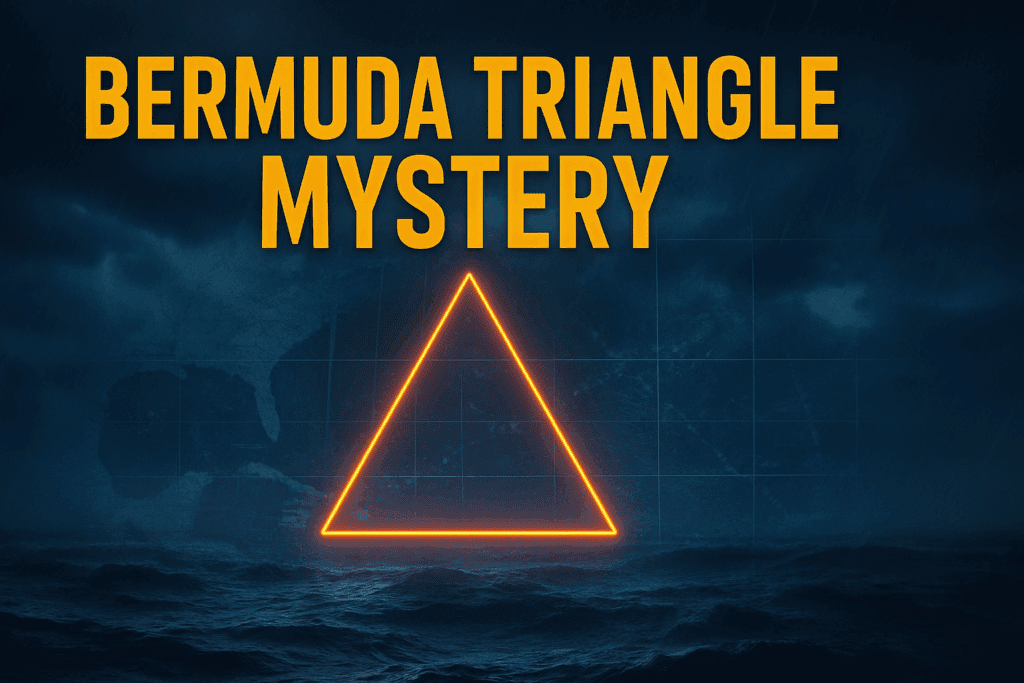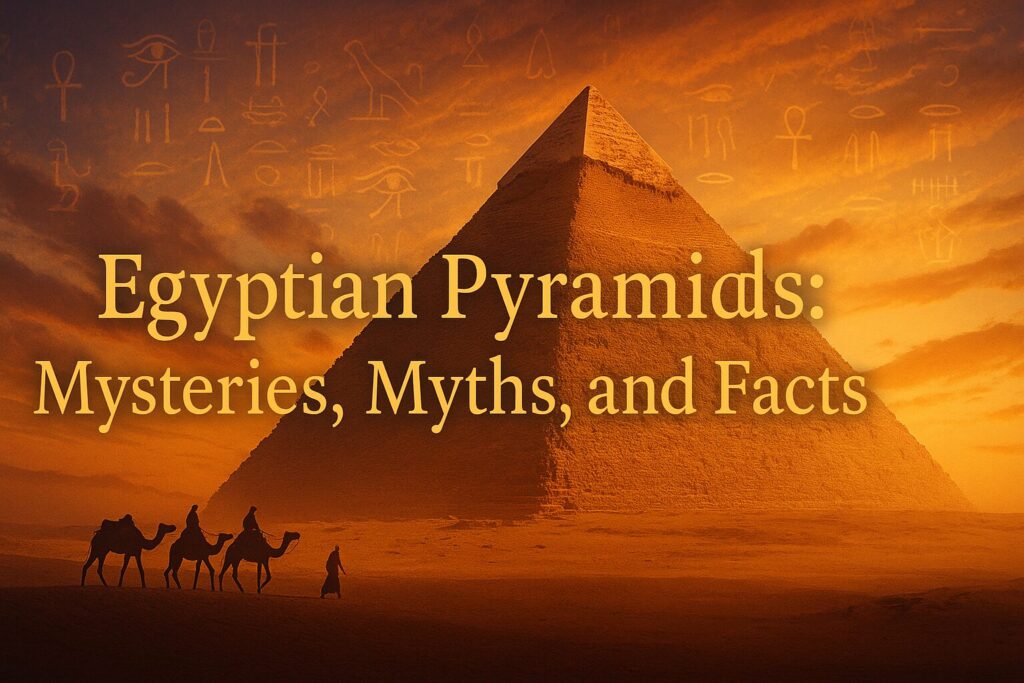Explore the Bermuda Triangle mystery with facts, famous disappearances, scientific theories, and supernatural legends. Discover if the Bermuda Triangle is real or fake.
Table of Contents
Introduction
The bermuda triangle mystery has fascinated explorers, scientists, and the public for decades. Spanning countless headlines and fueling imaginative theories, this enigmatic region of the Atlantic Ocean is blamed for the unexplained disappearances of ships and planes. Some call it the “Devil’s Triangle”; others argue it’s nothing more than myth and exaggeration.
Yet, whether you believe in paranormal forces or scientific explanations, the Bermuda Triangle remains an iconic part of modern folklore. In this guide, you’ll discover not only what the Bermuda Triangle is but also the most famous cases, credible scientific theories, and reasons why the legend endures to this day.
Ready to dive into one of the world’s greatest mysteries? Let’s begin by understanding exactly what the Bermuda Triangle is and why it has earned such an extraordinary reputation.
What Is the Bermuda Triangle? An Introduction to the Mystery
The Bermuda Triangle refers to a loosely defined area in the western North Atlantic Ocean where dozens of ships and aircraft are said to have vanished under unexplained circumstances. The term “bermuda triangle mystery” was popularized in the 1960s, capturing the imagination of millions around the world.
Unlike officially recognized geographic regions, the Bermuda Triangle has no precise boundaries. Still, most researchers and storytellers describe it as forming a rough triangle between:
- Miami, Florida
- San Juan, Puerto Rico
- Bermuda
This expanse covers approximately 500,000 to 1,500,000 square miles of ocean, depending on which definition you consult. Its vastness alone makes it challenging to distinguish genuine anomalies from the region’s heavy traffic and unpredictable weather.
What sets the Bermuda Triangle apart is not simply that vessels go missing oceans are dangerous everywhere but that:
- Many disappearances were sudden and reportedly without distress signals.
- Search crews often found no trace of wreckage.
- Some survivors described bizarre phenomena like malfunctioning instruments, strange fogs, or sudden water spouts.
Authors such as Vincent Gaddis, who coined the term “Bermuda Triangle” in a 1964 magazine article, fueled public interest by blending documented cases with dramatic storytelling. Over time, this area became synonymous with unsolved maritime and aviation disappearances, inspiring speculation about whether the bermuda triangle mystery is real or fake.
In the next section, we’ll pinpoint exactly where this triangle lies and explore what makes its location so intriguing.
Where Is the Bermuda Triangle Located? Map and Geographical Overview
The Bermuda Triangle forms a mysterious patch in the Atlantic Ocean, connecting three significant locations:
- Miami, Florida (Northwestern point)
- San Juan, Puerto Rico (Southeastern point)
- Bermuda (Northeastern point)
These three points create a triangle that stretches over 500,000 to 1.5 million square miles, depending on the range considered by researchers and writers. This region overlaps some of the busiest shipping lanes and flight paths in the world, which is why it has seen so much traffic and attention.
Here’s a closer look at the triangle’s geographic features:
- Gulf Stream: A powerful, warm Atlantic ocean current flows through this area. Known for its fast-moving waters and sudden storms, it can quickly erase debris from wrecks, complicating rescue and recovery missions.
- Deep Ocean Trenches: Some parts of the Bermuda Triangle are home to underwater trenches that plunge several miles deep, such as the Puerto Rico Trench, the deepest part of the Atlantic Ocean. Wreckage may never be found if it sinks into these underwater canyons.
- Subtropical Climate Zone: The region is prone to tropical storms, sudden fogs, hurricanes, and unpredictable weather often cited in scientific explanations for bermuda triangle disappearances.
Despite being a maritime hotspot, there’s no official map issued by any government marking the Bermuda Triangle. Its existence is more a matter of legend than geography. Still, countless naval charts, books, and online maps highlight this triangle because of the enduring popularity of the bermuda triangle mystery.
Next, let’s uncover when this mystery actually began and how it captured global attention.
History of the Bermuda Triangle: When Did the Mystery Begin?
Although tales of strange disappearances near Bermuda go back centuries, the bermuda triangle mystery became widely recognized only in the 20th century.
Here’s how the legend evolved:
- Christopher Columbus (1492): On his first voyage to the Americas, Columbus recorded in his logbook that his compass behaved erratically when sailing near Bermuda. He also reported seeing a “great flame of fire” crashing into the sea possibly a meteor and a mysterious light appearing in the distance. These early accounts laid the groundwork for later speculation.
- Flight 19 (1945): The incident that truly ignited public fascination occurred on December 5, 1945. Five U.S. Navy Avenger torpedo bombers, collectively called Flight 19, vanished during a training mission out of Fort Lauderdale, Florida. The squadron leader reported that his instruments had failed and that the ocean looked strange. A rescue plane sent after them also disappeared. No wreckage was ever conclusively found. This double disappearance was so shocking that it became the centerpiece of many books and articles about the bermuda triangle mystery.
- Vincent Gaddis (1964): In an article for Argosy magazine titled “The Deadly Bermuda Triangle,” journalist Vincent Gaddis coined the term “Bermuda Triangle.” He compiled stories of vanishing ships and aircraft to suggest there was something uniquely hazardous about this stretch of ocean.
- Charles Berlitz (1974): Berlitz’s bestselling book, The Bermuda Triangle, sold millions of copies and cemented the legend in popular culture. While critics pointed out factual errors and exaggerations in Berlitz’s work, his vivid storytelling ensured the Bermuda Triangle would remain a household term.
Over the decades, the list of disappearances grew as researchers and journalists documented dozens of unexplained losses, including commercial airliners, military craft, and cargo vessels. Each incident seemed to deepen the question: Is the Bermuda Triangle real or fake?
Next, we’ll examine some of the most famous disappearances that continue to fuel speculation.
Famous Bermuda Triangle Disappearances That Shocked the World
Throughout the last century, the bermuda triangle mystery has been fueled by high-profile disappearances. While some incidents have rational explanations, others remain unsolved, adding to the region’s mystique.
Here are some of the most famous cases:
- Flight 19 (1945):
This remains the most iconic Bermuda Triangle disappearance. Five Navy bombers on a routine training flight radioed that their compasses had failed. The pilots became disoriented and eventually ran out of fuel. All 14 crew members were lost, along with 13 more from a rescue plane that also vanished. No wreckage was ever definitively recovered. - USS Cyclops (1918):
This massive Navy collier was carrying over 300 men and 10,000 tons of manganese ore when it disappeared without a trace between Barbados and Baltimore. No SOS call was sent, and no debris was ever found. It remains the single largest non-combat loss of life in U.S. Navy history. - Star Tiger and Star Ariel (1948 and 1949):
These two British South American Airways passenger planes vanished less than a year apart while flying between Bermuda and Jamaica. Both disappeared without distress calls or any evidence of a crash. - Douglas DC-3 Flight NC16002 (1948):
A commercial airliner carrying 29 passengers disappeared 50 miles from Miami. The crew sent routine radio messages before the plane vanished. No wreckage was ever found despite intensive searches. - SS Marine Sulphur Queen (1963):
This tanker, carrying molten sulfur, disappeared with 39 crew members off the southern coast of Florida. Although a few pieces of debris were later recovered, the main wreck was never located. - Witchcraft (1967):
A cabin cruiser with two men aboard set out from Miami to enjoy the view of the city’s Christmas lights. Less than a mile offshore, the captain radioed the Coast Guard to report they had struck something but were in no danger and required a tow. When rescuers arrived just 19 minutes later, the Witchcraft had vanished without a trace.
Many of these disappearances share puzzling features: sudden loss of radio contact, failure to send distress calls, and complete absence of wreckage. While skeptics point to storms, navigation errors, and mechanical failures, these unresolved cases continue to fuel the question: Is the Bermuda Triangle really dangerous, or is it an exaggerated legend?
Next, we’ll look at the scientific theories that try to explain why so many ships and planes have disappeared here.
Scientific Theories About the Bermuda Triangle Explained
While the bermuda triangle mystery has inspired countless supernatural tales, many scientists believe there are perfectly natural explanations for the region’s reputation. Over the decades, researchers have proposed several compelling theories:
- Unpredictable Weather and Rogue Waves:
The Bermuda Triangle lies in a zone prone to sudden squalls, waterspouts, and hurricanes. Even today, storms can materialize with little warning, overwhelming ships or aircraft. Satellite data has also revealed the presence of rogue waves towering walls of water up to 100 feet high that can snap a vessel in two. - Methane Hydrate Eruptions:
Geological surveys have shown that pockets of methane gas can form under the seafloor. When they erupt, they create enormous bubbles that reduce water density. Ships floating above may lose buoyancy and sink almost instantly. Though no methane eruption has been definitively tied to a specific disappearance, laboratory experiments have demonstrated this phenomenon can occur. - Compass Variation and Magnetic Anomalies:
The Bermuda Triangle is one of the few places on Earth where true north and magnetic north align, which can create compass variation that confuses navigation. Early pilots and sailors relying on magnetic compasses could have easily veered off course without realizing it. - Gulf Stream Currents:
The powerful Gulf Stream moves swiftly through the Triangle, sometimes at speeds exceeding 5 knots. If a vessel becomes disabled, it can drift hundreds of miles in a short time, making wreckage nearly impossible to locate. - Human Error and High Traffic:
Because the Bermuda Triangle is one of the most traveled shipping lanes in the world, statistically, it’s inevitable that more accidents and disappearances occur there. Many researchers, including those cited by the U.S. Coast Guard, argue that the region’s incident rate is not significantly higher than comparable ocean areas.
Interestingly, in 2016, researchers from the University of Southampton analyzed satellite imagery suggesting unusual hexagonal clouds over the region could create airborne “microbursts” powerful downdrafts of wind that slam into the ocean, generating waves and turbulence capable of bringing down aircraft and ships. While this remains under study, it adds another possible factor to the scientific case.
While none of these theories completely solve every disappearance, together they offer a rational framework to explain much of the bermuda triangle mystery without invoking the supernatural.
Next, we’ll explore the more paranormal and exotic ideas that have captivated imaginations around the world.
Supernatural and Paranormal Theories: Aliens, Time Warps & More
While scientists lean toward natural causes, many people remain captivated by supernatural explanations for the bermuda triangle mystery. These ideas may lack hard evidence, but they continue to thrive in books, documentaries, and internet forums. Here’s a look at the most popular paranormal theories:
1. Alien Abductions
- One of the most widely discussed paranormal explanations is that extraterrestrials are responsible for the disappearances.
- Some theorists claim that the Bermuda Triangle acts as a “cosmic hotspot” for alien activity, where UFOs abduct ships and planes for study.
- This idea gained traction after stories emerged of aircraft disappearing suddenly without radio contact, as if plucked from the sky.
2. Time Warps or Portals
- Some believe the Bermuda Triangle is a gateway to another dimension or a tear in the space-time fabric.
- Survivors have claimed odd time distortions or temporary loss of space awareness. One pilot, Bruce Gernon, reported flying through a “cloud tunnel” and experiencing a time jump, arriving in Miami far earlier than expected.
- Though never verified scientifically, this “time vortex” concept remains a favorite among mystery enthusiasts.
3. Atlantis Energy Crystals
- Some fringe theorists link the Bermuda Triangle to the lost city of Atlantis. According to this idea, ancient Atlantean technology lies buried beneath the ocean floor, emitting energy beams that interfere with navigation systems.
- The Bimini Road a submerged rock formation off the coast of the Bahamas is often cited as potential evidence of this theory.
4. Ghost Ships and Curses
- Reports of phantom ships drifting without crews have contributed to the Triangle’s haunted reputation.
- Others suggest the area is cursed, possibly tied to ancient shipwrecks or indigenous legends. However, no concrete historical curse has ever been documented.
5. Electronic Fog
- Some pilots have reported flying into a dense, electrically charged fog where instruments malfunction and time seems distorted.
- Bruce Gernon’s “electronic fog” account is often cited, though it’s highly anecdotal and remains controversial among experts.
While these theories are largely dismissed by mainstream science, they remain essential to the enduring legend of the bermuda triangle mystery. Their appeal lies in their imaginative reach and in our human desire to explain the unexplainable.
Next, we’ll take a grounded look at what the actual data and statistics tell us about the dangers of this infamous region.
Is the Bermuda Triangle Really Dangerous? What the Data Says
Despite its chilling reputation, modern data suggests the bermuda triangle mystery may not be as dangerous as legends claim. In fact, multiple studies and official sources have challenged the idea that this area poses unique risks to ships and aircraft.
What the Numbers Actually Say
- According to Lloyd’s of London, one of the world’s leading insurance markets, the Bermuda Triangle is not statistically more dangerous than any other part of the ocean.
- The U.S. Coast Guard also states that the Triangle’s disappearance rates are comparable to heavily traveled regions around the world.
- A 2013 report by the World Wildlife Fund on the world’s most dangerous waters did not list the Bermuda Triangle in its top 10.
These findings suggest that the bermuda triangle disappearances often attributed to paranormal forces may be better explained by:
- High traffic density: The area includes major routes for both sea and air travel. Naturally, more vessels increase the chance of incidents.
- Volatile weather patterns: The region is subject to hurricanes, sudden squalls, and violent ocean currents like the Gulf Stream.
- Human error and mechanical failure: Especially in earlier decades, navigation tools were primitive compared to today’s technology.
Modern Technology Has Reduced Incidents
- With GPS navigation, weather satellites, and improved communication systems, pilots and captains are now better equipped to handle the risks.
- As a result, the number of unexplained disappearances has dramatically declined in recent years.
Misreporting and Media Hype
Many cases often cited as part of the bermuda triangle mystery were later explained by:
- Misreported details or second-hand accounts.
- Accidents far outside the traditional Triangle boundaries.
- Resolved investigations that were not as mysterious as originally portrayed.
In short, while the Bermuda Triangle has been the setting for strange and tragic events, the data does not support the claim that it’s uniquely hazardous.
Yet, the myth persists. Why? Partly because of how embedded it is in pop culture something we’ll explore in upcoming sections.
How Do Ships and Planes Navigate Through the Bermuda Triangle?
Despite the chilling tales surrounding the bermuda triangle mystery, thousands of vessels and aircraft pass through the area every year without incident. In fact, this region is so heavily trafficked because it connects major ports in the Americas, Europe, and the Caribbean.
So how do modern ships and planes handle the risks? Here’s how:
1. Advanced Navigation Systems
- Global Positioning System (GPS): Today’s commercial pilots and captains rely on satellite-based GPS, which is far more reliable than the magnetic compasses of earlier eras.
- Inertial Navigation Systems (INS): Aircraft use gyroscopes and accelerometers to track their positions, even if GPS briefly fails.
- Electronic Chart Display and Information Systems (ECDIS): Ships plot their routes digitally, continuously updated with live weather and traffic data.
These technologies reduce the chance of navigational errors once a major factor in many bermuda triangle disappearances.
2. Weather Tracking and Avoidance
- NOAA satellites and specialized meteorological services monitor the Atlantic around the clock.
- Pilots receive real-time updates on turbulence, storms, and squalls.
- Ships use oceanographic forecasts to avoid rogue waves and dangerous currents.
Many disappearances that fueled the bermuda triangle mystery happened before such data was widely accessible.
3. Strict Safety Protocols
- Flight plans are filed with clear check-in times at multiple waypoints.
- Vessel Traffic Services (VTS) track ship positions along shipping lanes.
- If contact is lost, emergency locator transmitters activate automatically, aiding search and rescue.
4. Training and Regulation
- Crew training now emphasizes awareness of compass variation in the region, reducing the likelihood of disorientation.
- International maritime and aviation authorities have standardized protocols for crossing high-risk areas.
5. Routine Passage
It’s important to note that airlines such as American Airlines, Delta, and cargo carriers fly over the Bermuda Triangle daily. Major cruise lines, including Royal Caribbean and Carnival, routinely sail through this region.
For most navigators today, the bermuda triangle mystery is simply part of maritime folklore rather than an operational concern.
Next, we’ll look at how books, films, and documentaries have transformed this area into a cultural phenomenon.
Popular Movies and Books About the Bermuda Triangle
Part of the reason the bermuda triangle mystery has endured for generations is its larger-than-life portrayal in movies, books, and documentaries. Since the 1960s, storytellers have mined the Triangle for tales of suspense, supernatural intrigue, and speculative science fiction.
Here are some of the most influential works that shaped public fascination:
Books
- “The Bermuda Triangle” by Charles Berlitz (1974):
This international bestseller did more than any other book to popularize the legend. Berlitz blended documented cases with dramatic interpretations, arguing that the Triangle’s dangers were real and unexplained. Although later criticized for inaccuracies, the book sold millions of copies and became a cultural touchstone. - “Limbo of the Lost” by John Spencer (1977):
Spencer expanded on Berlitz’s ideas, suggesting that advanced civilizations or unknown forces were behind the disappearances. - “Into the Bermuda Triangle” by Gian Quasar (2003):
Quasar took a more investigative approach, compiling case files and eyewitness accounts to argue that the mystery remains unsolved.
Films and TV Documentaries
- “The Bermuda Triangle” (1978):
This Mexican horror film imagined a doomed voyage into the Triangle, blending supernatural suspense with maritime disaster. - “Close Encounters of the Third Kind” (1977):
While not solely about the Bermuda Triangle, Steven Spielberg’s classic sci-fi film referenced Flight 19, implying that aliens were involved in their disappearance. - History Channel’s “The Bermuda Triangle: Beneath the Waves” (2004):
This documentary explored scientific theories, from methane hydrates to rogue waves, using underwater investigations and expert commentary. - National Geographic’s “Drain the Bermuda Triangle” (2014):
By digitally “draining” the ocean, this documentary visualized how submerged wrecks and unique seabed features might explain many disappearances.
Cultural Impact
These stories have become so deeply woven into popular culture that the Bermuda Triangle is now a metaphor for any mysterious disappearance. References appear in everything from children’s cartoons to music videos, ensuring new generations continue to ask whether the bermuda triangle mystery is real or fake.
Next, let’s consider why this fascination endures despite decades of investigation and skeptical analysis.
Why Does the Bermuda Triangle Still Fascinate People Today?
Even with decades of research and debunking, the bermuda triangle mystery continues to grip our collective imagination. But why does this legend persist in the age of satellites and global positioning systems? Several factors help explain its enduring allure:
1. Humans Love a Good Mystery
- We’re naturally drawn to unexplained phenomena. The idea that in a world mapped down to every inch, there could still be a place where ships and planes vanish without trace is simply irresistible.
- The Bermuda Triangle symbolizes the unknown something both terrifying and thrilling.
2. Media and Pop Culture Amplification
- Books, movies, and documentaries have consistently presented the Triangle as a supernatural or extraterrestrial hotspot.
- Sensational headlines about disappearances create lasting impressions, even when follow-up investigations reveal mundane explanations.
3. Psychological Pattern-Seeking
- Humans look for patterns, even in random data. When numerous incidents occur in a single area especially an area with heavy traffic it feels like a meaningful connection, not mere coincidence.
- This cognitive bias, called apophenia, makes the bermuda triangle mystery seem more real than the statistics support.
4. The Appeal of Hidden Forces
- The notion that ancient Atlantis energy crystals, time warps, or alien abductions could exist just offshore taps into our deepest fascination with hidden forces shaping our world.
- These ideas allow us to imagine that we’ve only scratched the surface of Earth’s secrets.
5. Enduring Unresolved Cases
- Despite advances in technology, some disappearances like Flight 19 and the USS Cyclops remain unsolved.
- The lack of closure fuels speculation and keeps the mystery alive, generation after generation.
Ultimately, the bermuda triangle mystery endures because it lives at the crossroads of science, folklore, and the human love of adventure. It challenges our sense of security and dares us to believe there may still be places on Earth beyond our understanding.
Finally, let’s wrap up with a clear-eyed conclusion about what this enigmatic area means today.
Conclusion
The bermuda triangle mystery has evolved from obscure maritime lore into one of the most famous legends of the modern world. Over the decades, it has been linked to alien abductions, time warps, and cursed seas yet careful investigation shows that the majority of incidents have plausible explanations rooted in weather, human error, and natural forces.
Still, the mystery endures. Why? Because the Bermuda Triangle sits at the edge of what we know and what we can prove. Even in an age of satellite surveillance and real-time tracking, some disappearances remain unexplained, and some questions remain unanswered.
This is what gives the bermuda triangle mystery its staying power. It speaks to something universal in human nature: a yearning to explore, to understand, and sometimes to believe in forces beyond our comprehension.
Whether you see it as a cautionary tale about the ocean’s power or a genuine enigma that challenges our understanding of reality, the Bermuda Triangle continues to inspire curiosity, debate, and storytelling across generations.
As we learn more about our planet’s hidden frontiers, one thing is clear: legends like the Bermuda Triangle remind us that mystery itself is part of what makes exploration so compelling.





